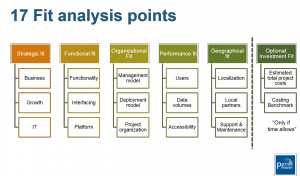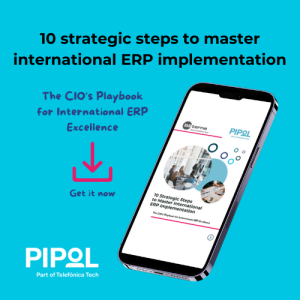NAV or AX: what and how to choose
Dynamics NAV or AX: which product is the best fit for your international organization?
NAV or AX – choosing the right Dynamics ERP for your multi-country organization may seem simple on paper, but the reality is much more complex! You can rely on the official Dynamics product positioning up to a certain point but you will soon realize that in reality it isn’t that straight forward. Why? Simply because every organization is unique and each product can be suitable for international deployments.
Based on experience from hundreds of projects, I have developed a 17 points analysis model that I have used to help companies determine the product with the best fit without going through expansive and time consuming analysis of product and functional features. The logic is that first we look at the long term fit to the business strategy and second we look at process functional fit which is most often a project phase rather than a pre-project phase, at least on a detailed view.
So, how to do it? Well, a traditional product selection approach would be to evaluate software solely based on a thorough functional fit and vendor analysis. This is way too much time and resource consuming and I have found that it does not guarantee that you will be making the right choice because of the complexity of ERP processes. Instead, I have chosen to focus mostly on the strategic fit between the products and the company’s business strategy in regards to how to manage and service subsidiaries / affiliates.
Make the right decision
I basically suggest to investigate 6 key areas:
- Strategy: What is the company’s business strategy? What is their geographical coverage and what are their growth plans? How do they compete? What are their global processes? Which processes are and should remain local?
- Functionality: Yes, I do check that on module level, but I stick to the standard functionality, only identifying the major gaps in the products and the key requirements from the company’s side where it’s likely that there are specific requirements. A part of this is also to investigate the need for shared or integrated operational data.
- Organizational structure: How (de)centralized is the organization’s structure today? Are they moving towards a different model? Does the company have the management, delegation, the structure, processes and organizational behavior to be a sustainable platform to support the future state vision?
- Performance: What is the volume of data? The number of users at every site? How will the data volume develop over 5-10 years?
- Geographies: Which are the countries in scope now and in the future? Are they supported by a localization and what is the availability of local partners to provide support?
- Investment: What size of investment should be foreseen?+ How long will it take to accomplish? This analysis can be extended with a real business case evaluation, but typically this is made as an internal task, hence not a deliverable from the 17 points analysis.?
More concretely we analyze the 17 fit gap points shown in this picture:
Is that all? Nearly. In order to ensure a successful product selection you need one more ingredient; you need management involvement! So, NAV or AX? Selecting the right solution requires deep understanding of the current business strategy, corporate management requirements, expectations to local market development and local market drivers, organizational behavior and the desired future state scenario for the company. It is by all means a management task and mostly requires management involvement.
Update:
Today, you might want to upgrade Dynamics AX to Dynamics 365 since mainstream support ended in October 2021.






